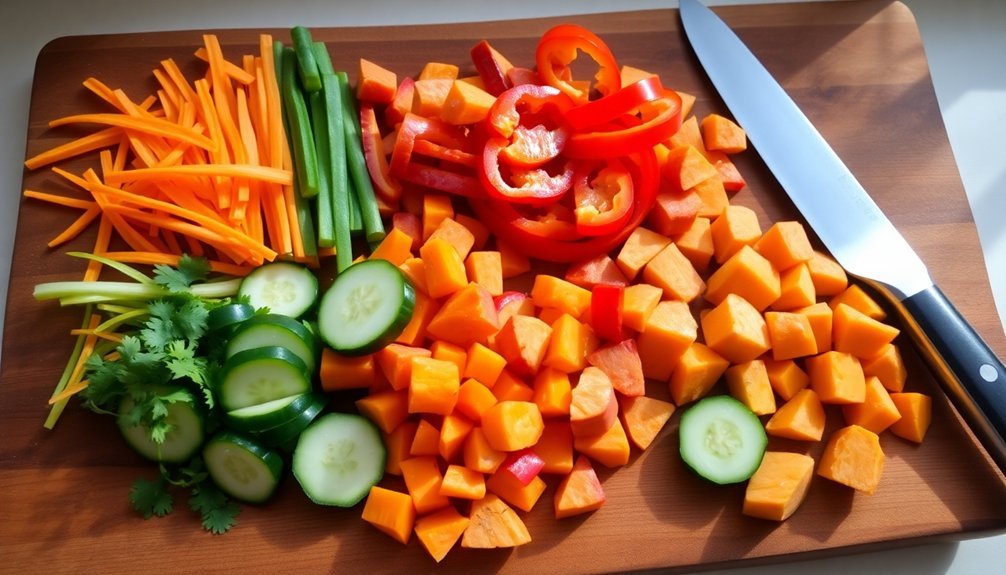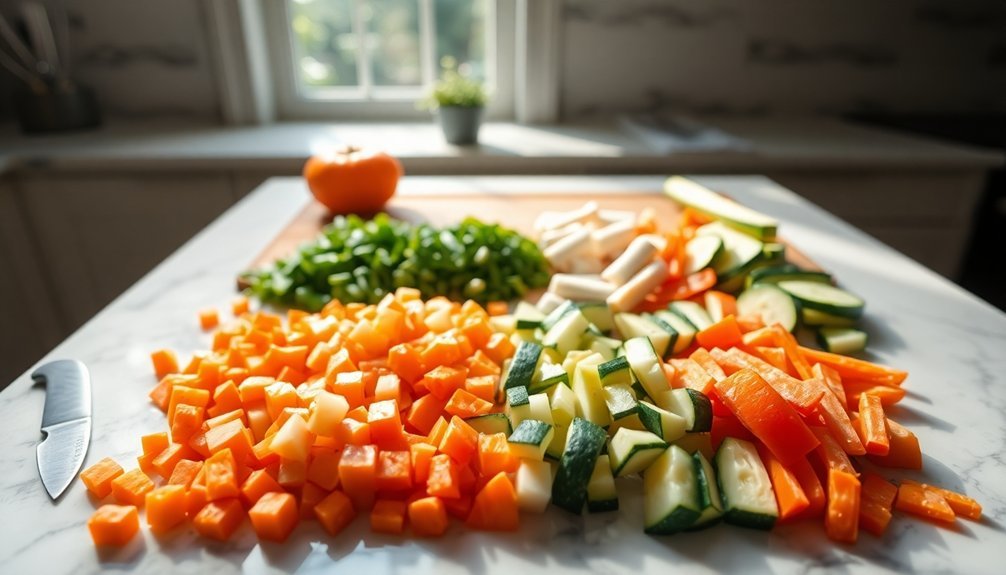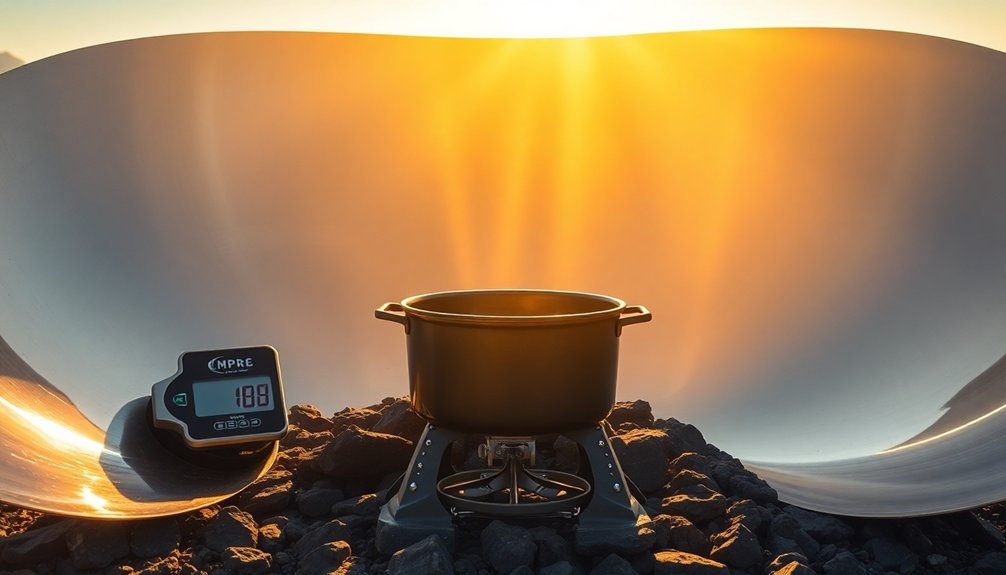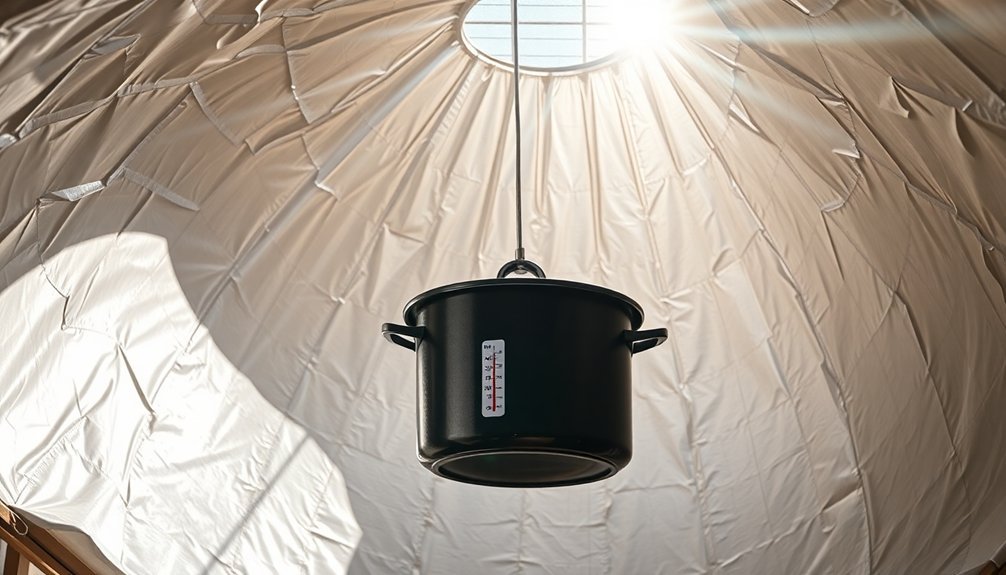Cut your vegetables into uniform, bite-sized pieces (2-3 inches) using a sharp knife and controlled slicing motion to guarantee even cooking in your solar cooker. For proteins, portion meat and poultry into 1-inch cubes, while fish and tofu should be sliced into ½-inch pieces – this allows proper heat distribution and reduces overall cooking time by up to 50%. Arrange all ingredients in a single layer within dark-colored pots, avoiding overcrowding that can lead to uneven results. These sizing guidelines serve as your foundation for mastering the art of solar cooking, with many more techniques to discover.
Uniform Vegetable Cutting Basics

A sharp knife gliding through crisp vegetables is the foundation of successful sunbaked meals. You'll need to master basic cutting techniques to guarantee your ingredients cook evenly and present beautifully on the plate.
Start by creating a flat surface on rolling vegetables – this gives you stability for precise cuts. When you're ready to slice, use your knife in a controlled motion rather than hacking, and always maintain the "claw grip" to protect your fingers. For vegetables like carrots and cucumbers, aim for 2-3 inch lengths when cutting strips.
You'll want to focus on achieving uniform sizes, whether you're dicing, julienning, or batonnetting, as this guarantees even cooking in the sun's heat.
Remember to trim away tough stems and inedible parts before you begin, and work methodically from simple cuts to more complex ones to maintain control and prevent fatigue.
Protein Portioning For Solar Cooking
Three key factors determine success when portioning proteins for solar cooking: size consistency, thickness, and arrangement. You'll want to cut your proteins into uniform, smaller pieces to guarantee even cooking and reduce overall cooking time. For best results, keep portions between 1-2 inches thick.
| Protein Type | Recommended Cut Size | Best Cooking Time |
|---|---|---|
| Meat/Poultry | 1-inch cubes | 2-3 hours |
| Fish/Tofu | ½-inch slices | 1-2 hours |
| Legumes | Whole or split | 3-4 hours |
Remember to marinate your proteins beforehand for enhanced flavor and tenderness. When placing them in your dark-colored cooking vessel, arrange pieces in a single layer rather than stacking. This allows heat to distribute evenly and prevents undercooked spots. Don't forget to account for the sun's position during peak cooking hours. Using black cooking pots will maximize heat absorption and improve cooking efficiency.
Quick Ingredient Size Guide

Proper ingredient sizing makes a dramatic difference in solar cooking success.
You'll want to cut all your ingredients into smaller, uniform pieces to guarantee they cook evenly and efficiently. This simple step can slash your cooking time by up to 50%. For detailed sizing guides, you can double-click words in your digital recipe to quickly select and reference specific measurements.
For vegetables and fruits, aim for bite-sized chunks that'll cook through consistently.
When preparing meat, cut it into portions that'll fit well in your solar-safe pot while leaving room for proper air circulation. You'll need to match your portions to your cooker's capacity – don't overcrowd the container.
Remember that weather affects cooking times, so you'll need to adjust your ingredient sizes accordingly.
On cloudy days, cutting items slightly smaller can help compensate for reduced solar intensity and maintain efficient cooking times.
Frequently Asked Questions
How Long Can Ingredients Stay Fresh in Transit During Summer Months?
You'll want to limit transit time to 2-4 hours for fresh ingredients during summer months. Without proper cooling, your produce can lose freshness quickly, especially when temperatures exceed 75°F (24°C).
Can I Save Unused Portions of Pre-Portioned Ingredients for Later Use?
Yes, you can save unused pre-portioned ingredients. Just store them in airtight containers and label with dates. They'll stay fresh in your fridge, and you'll reduce waste while maintaining portion control for future meals.
What Kitchen Tools Are Essential for Proper Ingredient Preparation?
You'll need a chef's knife, cutting board, measuring cups and spoons, strainer, peeler, and digital scale for basic prep. Don't forget a good whisk and spatulas for mixing ingredients.
Are There Specific Storage Requirements for Partially Used Seasonal Ingredients?
You'll need to store partially used seasonal ingredients properly: refrigerate cut vegetables at 40°F, use airtight containers, keep herbs in water, and label everything with dates. Don't forget to check freshness regularly.
How Do Altitude Differences Affect Solar Cooking Times and Ingredient Portions?
At higher altitudes, you'll need to increase your cooking times considerably and add more liquid (up to 25% extra above 8,000 ft). You'll also want to adjust ingredient portions to compensate for faster evaporation.
In Summary
Size your ingredients properly and you'll get consistent results every time you cook with solar power. Keep vegetables uniform at 1-inch pieces, portion proteins into 4-ounce servings, and refer to the quick guide when you're unsure. With these prep fundamentals mastered, you're ready to harness the sun's energy for perfectly cooked, evenly heated meals that'll impress your outdoor dining guests.





Leave a Reply